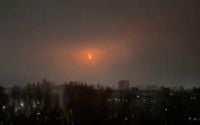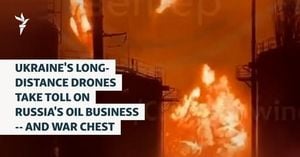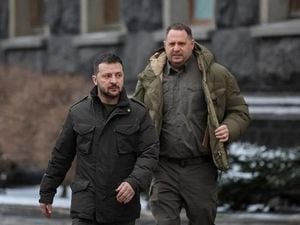In the early hours of November 28, 2025, the conflict between Ukraine and Russia reached a new level of intensity as Ukrainian forces launched a sweeping series of drone strikes deep into Russian territory and occupied regions. According to Ukraine’s General Staff, this meticulously coordinated attack targeted a range of high-value infrastructure, including the Saratov oil refinery in Saratov Oblast, a drone storage depot at the Saky airfield in Russian-occupied Crimea, and several military and logistical sites across Donetsk and Luhansk oblasts.
Residents in multiple Russian cities and occupied Crimea awoke to the sounds of explosions and the ominous whirring of drones overhead. Local Telegram channels, such as Exilenova+, were flooded with videos and messages from Saratov, where the night sky was intermittently lit by the flashes of air defense fire and distant blasts. Saratov, a city in Russia's Volga region more than 600 kilometers from the front lines, had rarely witnessed such direct action since the full-scale invasion began.
Russia’s Defense Ministry was quick to respond, announcing that its air defenses had intercepted a total of 136 Ukrainian drones overnight. Of these, 30 were reportedly downed over Saratov Oblast, 46 over Rostov Oblast, 29 above occupied Crimea, and the remainder scattered across Bryansk, Volgograd, Voronezh, Kaluga, and even the Moscow region. Despite these claims, Ukrainian officials confirmed that their drones had successfully struck several intended targets, with videos and photos circulating on Russian and Ukrainian social media showing fires and smoke rising from the Saratov refinery area.
The Saratov oil refinery, a critical node in Russia’s energy network, produces more than 20 types of petroleum products—ranging from gasoline and diesel to fuel oil and technical sulphur. The facility is a key supplier for Russia’s occupation forces in Ukraine. According to Ukraine’s General Staff, explosions at the refinery were followed by a significant fire, although the full extent of the damage was still being assessed as of press time. This attack marked the fifth strike on the refinery since the start of the season, with a previous hit on November 14 reportedly forcing the plant to halt primary processing, as Reuters noted. The repeated targeting of this facility underscores Ukraine’s ongoing strategy to disrupt Russian military logistics by hitting fuel supplies at their source.
Meanwhile, in Crimea, Ukrainian drones zeroed in on the Saky airfield in Novofedorivka, a site known for housing advanced Russian unmanned aerial vehicles (UAVs). The General Staff reported that after neutralizing Russian air defenses—including the Pantsir-S1 and Tor-M2 missile systems—Ukrainian forces destroyed a hangar storing long-range Orion and Forpost drones. Additional targets included a command and control post and a KamAZ military truck. The attack’s aftermath was felt beyond the airfield: a fire was reported near the Saky thermal power plant at the Yodobrom scientific and production association, a facility producing chemical equipment and located just 250 meters from the power plant. Local Telegram channels described a night punctuated by the sounds of drones, gunfire, and explosions.
In the occupied territories of Donetsk and Luhansk oblasts, Ukrainian forces continued their campaign against Russian supply lines, striking concentrations of troops and hitting fuel and lubricant depots. Ukraine has routinely targeted oil facilities and logistical hubs in both Russia and occupied Ukrainian regions, aiming to choke off Moscow’s ability to sustain its military operations. The overnight strikes on November 28 represent a significant escalation in this campaign, with the Ukrainian military openly touting the disruption caused to Russian logistics and energy infrastructure.
Commander Robert “Madyar” Brovdi of the Unmanned Systems Forces (SBS) provided further insight into the operation. He revealed that Ukrainian drones struck ten targets overnight, spanning both military and critical energy infrastructure. Among these, high-voltage substations between Luhansk and Rostov Oblast were disrupted, compounding the logistical headaches for Russian forces. Brovdi described the Saratov refinery strike with a touch of dark humor, saying it had “sprung a leak in the swamps,” and claimed the operation caused disruptions in oil and gas supplies. He characterized the strike as a “courtesy visit” by the SBS’s 1st Separate Center (formerly the 14th SBS Regiment) and the Graf unit, warning that future operations would be “more intense and louder.”
On the Russian side, the official response was predictably defensive. The Ministry of Defense insisted that the vast majority of drones had been intercepted, minimizing the impact of the attacks. Regional authorities, however, reported a patchwork of damage and disruption. In Rostov Oblast, Governor Yuri Slusar detailed drone strikes across several districts and cities, with fragments damaging cars, shattering windows, and breaking balconies. In the city of Taganrog, private homes sustained damage, while in Shakhty, a high-rise building’s balconies were hit. Moscow Mayor Sergei Sobyanin confirmed that two drones had targeted the capital, prompting emergency services to clear debris and assess the situation. Voronezh Oblast’s governor, Alexander Gusev, reported the destruction of two UAVs and minor damage to a residential building and a gas station.
Russian media outlet ASTRA, citing eyewitness accounts and its own analysis, confirmed fires and smoke in Saratov, particularly in areas of private housing. However, as is often the case in the fog of war, official data on the scale and consequences of the attacks remained fluid, with clarifications and updates continuing throughout the day.
For Ukraine, these strikes serve multiple strategic purposes. Hitting oil refineries, drone depots, and command centers not only depletes Russia’s military resources but also sends a message about Kyiv’s growing reach and technological capability. The use of drones—cost-effective, hard to intercept, and increasingly sophisticated—has become a hallmark of Ukraine’s asymmetric approach to countering Russia’s larger and better-equipped forces. Each strike deep inside Russian territory rattles Moscow’s sense of security and forces the Kremlin to divert resources to homeland defense.
Yet, the broader impact of these attacks remains to be seen. While Ukraine’s military celebrates the disruption of Russian logistics and the damage to key infrastructure, Russian authorities continue to assert control and downplay losses. As the situation evolves, it’s clear that both sides are locked in an escalating contest of technology, willpower, and resilience, with the war’s front lines now stretching far beyond the trenches of eastern Ukraine.
As the smoke clears over Saratov and Crimea, both Ukrainian and Russian officials are left to tally the costs, recalibrate their strategies, and prepare for whatever comes next. With warnings of even more intense strikes on the horizon, the war’s reach—and its consequences—continue to expand.




